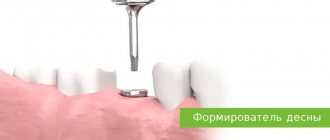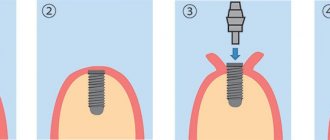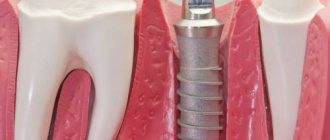We treat gums - save teeth
Due to the widespread distribution, labor intensity and low effectiveness of treatment of advanced stages, periodontal diseases are one of the most difficult problems in dentistry. Thus, according to WHO, about 95% of the adult population of the planet and 80% of children have some signs of periodontal tissue disease, and this statistics cannot but be alarming. Periodontitis not only causes tooth decay and bad breath, but also leads to tooth loss.
In recent years, tooth extraction due to gum inflammation and periodontal pathology is almost five times higher than tooth loss from caries and its complications, leading dentists to the need to find new approaches to the treatment and prevention of these diseases.
Average cost in Moscow
Here are the approximate prices in metropolitan clinics for implantation and other dental services related to it.
| Name of service | Cost, rub. |
| Turnkey implantation | |
| Classical implantation with installation of a metal-ceramic crown | 39100 |
| Classical implantation with installation of an all-ceramic crown | 50200 |
| Removable prosthesis on implants with ball-shaped fastening | 54700 |
| Express implantation with installation of a metal-ceramic crown | 58000 |
| Classical implantation with installation of a ceramic crown on a special alloy | 60000 |
| Removable denture on implants with beam fastening | 160000 |
| Installation and removal of implants | |
| Installation of the healing abutment | 3700 |
| Implant removal | 6900 |
| Implantation of osteoconductive material in the area of 1 tooth | 9600 |
| Installation of a mini implant | 11700 |
| Implantation of a protective membrane of 1 tooth | 12700 |
| Installation of a temporary implant | 14700 |
| Express implantation (in one stage) of 1 tooth | 33900 |
| Classic implantation of 1 tooth | 44800 |
Cost of medications to relieve inflammation and pain at home
| Medication | Cost, rub. |
| Chlorhexidine 0.05% | 60 |
| Betadine 10% | 270 |
| Solcoseryl | 300 |
| Amoxiclav | 330 |
| Dexalgin | 400 |
About the problem of gum inflammation
Of all gum diseases, 90–95% are inflammatory, such as gingivitis and periodontitis. When healthy, the gum covers the bone and connects to the surface of the tooth at the neck. There is a small groove between the gum and the tooth, only one or two millimeters deep. The gingival sulcus is a natural protective barrier against infection.
Inflammation of the gums begins with gingivitis, which affects only the superficial tissues of the gums. In turn, periodontitis is an inflammatory disease that affects the entire complex of supporting tissues of the tooth: gums, ligaments and bone. In fact, gingivitis and periodontitis are two interrelated forms of the disease.
The inflammatory process first occurs in the gum tissue and gradually involves the closest periodontal structures - the dentogingival ligament and the dentofacial bone. The initial signs of the disease are bleeding gums, an unpleasant odor, and the presence of dental plaque. For many years, periodontitis can be painless, or even completely asymptomatic.
Often the patient consults a doctor with an already severe stage of the disease, when tooth mobility appears and the need to correct the bite arises. It is no secret that many people do not pay attention to bleeding gums when brushing their teeth, exposure of the necks of their teeth, and get used to bad breath. Those who believe that these are simply weak, inflamed gums, and that bad breath has a different origin, are deeply mistaken.
The lack of timely, qualified treatment leads to complete loss of teeth, since the inflammatory process in the gums is accompanied by resorption of the supporting bone. Today, periodontal tissue diseases are not only a medical, but also a social problem. This state of affairs is primarily due to their widespread prevalence, as well as the intensity of damage to all age groups of the population of our country.
For example, in adolescents, certain signs of periodontal disease (bleeding gums, tartar, etc.) are detected in 90% of cases, and in older age (30-40 years or more), pronounced inflammatory and destructive changes in the entire periodontal complex with the formation of pockets predominate , suppuration, loose teeth and tooth loss.
Condition of the gums at the orthopedic stage of implantation
Gingival contour formation and abutment
Before installing the prosthesis, it is necessary to install a former to create the correct gingival contour. Its fixation does not take much time (about 20 minutes) - an incision is made in the gum, the plug is unscrewed and the former is fixed under the influence of a local anesthetic. After a week or two, you can begin prosthetics.
After the former, an abutment is placed, which acts as a connecting link between the implant and the crown. It is selected individually and should protrude slightly beyond the gums.
Gum formation is an important point in dental implantation. It is he who will subsequently determine during prosthetics what the gums will look like after prosthetics in the smile area. A tight fit of the crown or prosthesis in the frontal and chewing area will prevent unwanted penetration of bacteria into the gap between the gum and the artificial tooth.
Stage of prosthetics on an installed implant
Prosthetics recreate the complete appearance of the dentition. The emphasis is placed not only on the natural appearance of artificial teeth, but also on their functionality. This is the stage of joint work between an implantologist and an orthopedist.
The crown is made individually based on pre-made impressions. Before final fixation, several fittings and adjustments are carried out. On average, this takes from 2 to 4 weeks. Fixation of the orthodontic structure depends on its type.
After installing a crown or denture, the gums should have a natural appearance. The design should not press, rub or cause discomfort. Otherwise, you need to consult a doctor.
Causes of gum inflammation?
After each meal, a small amount of food debris remains on the teeth and between the teeth, which forms a soft plaque. It is difficult to see, but oral microorganisms immediately settle in it. If plaque is not regularly removed from the surface of the tooth, it turns into tartar as a result of the deposition of salivary salts - a substrate for bacterial colonies.
The accumulation of bacterial plaque and waste products of microorganisms in the area of the gingival sulcus leads to gingivitis, subsequently to the destruction of the sulcus, the formation of periodontal pockets, the development of periodontitis and damage to bone tissue. Inflammation of the gums develops faster when the general defenses of the body are weakened, with dental caries, after a tooth injury (for example, with a blow, microtrauma when biting a thread), after unsuccessful prosthetics.
Diseases such as hypertension, diabetes, diseases of the thyroid gland and adrenal glands lead to serious changes in the entire body, including the periodontium. Patients with this pathology should be under constant supervision of a periodontist and therapist. Regular visits to these specialists allow you to successfully treat gum inflammation and save teeth in the presence of general diseases of the body.
Plaque, which is the main cause of gum disease, contains a huge variety of bacteria that can spread to other organs. In this regard, periodontal pockets are centers of chronic infection. It has been proven that the long-term presence of infection in such a formation leads to the development of rheumatoid arthritis, infective endocarditis, gastritis and enterocolitis.
Gum recession - symptoms and treatment
Since recession gradually progresses and can turn into a serious complication, it is necessary to undergo timely therapy in the early stages of the disease. This guarantees the effectiveness of complete cure of recession and getting rid of cosmetic defects.
The main treatment for gum recession [6] involves surgery. Thanks to the operation, the gingival contour is restored and the tooth root is closed. However, treating recession with surgery is not suitable in all cases. For example:
- surgical treatment of class I and class II recessions allows for maximum coverage of the tooth root surface;
- in the surgical treatment of class III recession, full success is observed only in some cases;
- For class IV pathology, surgical operations are not performed.
Who is indicated for the removal of dental recessions?
Carrying out such a procedure is necessary if:
- the client is not satisfied with this defect for aesthetic reasons;
- tooth enamel is highly sensitive;
- orthopedic therapy is planned;
- progression of the disease is observed.[7]
Methods of surgical treatment
Surgical treatment involves obtaining excellent results and guaranteed elimination of all symptoms of the disease. In this case, surgical intervention can be carried out using one of the following methods.[8]
Lateral flap technique . To perform the manipulation, a fragment on a stem is used, which is taken from areas adjacent to the operation site. Such plastic surgery is allowed if there is a sufficient amount of soft tissue.
At the initial stage of therapy, the doctor eliminates inflammation and eliminates deposits on the teeth. After this, a flap for transplantation occurs (as a rule, it is formed from gum tissue or hard palate). The final stage involves suturing the fabric. The use of local anesthesia is mandatory.
The relevance of this technique remains in both localized and generalized forms of the disease. Its advantage is considered to be effective restoration, since the materials are 100% identical. The only drawback of the manipulation is the feeling of slight discomfort for some time at the site of donor tissue collection. There are also cases when the flap does not take root in the transplanted area.
Resorbable membranes. This procedure belongs to the classic methods of treating gum recession and can effectively eliminate it. The manipulation is carried out in two stages:
- they begin with the installation of a membrane that has high rigidity, which avoids repeated intervention;
- after some time, the membranes are removed.
It should be noted that such operations are characterized by poor results: damaged tissues may not recover completely. Therefore, progressive doctors try not to use this technique.
Therapy with regeneration potentials of biological elements. The basis for these components are certain components that contribute to the rapid formation of renewed healthy gums. For this purpose, protein enzymes and the substance amelogenin are used. They form high-quality enamel and help restore the structure of tooth roots, and the enamel matrix allows the formation of a hard layer on damaged gum tissue.
Non-surgical treatment
A conservative method is to treat gum recession with collagen . It is recommended mainly at the initial stage of development of the disease, when slight exposure of tooth roots occurs. With the help of collagen, an excellent effect is achieved, especially if gum recession occurs due to inflammatory manifestations. When this component is introduced into the gum tissue, an aesthetic improvement of the damaged area occurs. In addition, the exposed area of the tooth is covered, which avoids undesirable effects on the general condition.[1][8]
Choosing a treatment method
Analyzing the reviews of patients and dentists about the listed therapeutic methods for treating gum recession, you can see how diverse they are.
The thing is that for some patients conservative treatment methods are perfect. However, others note that surgical intervention turned out to be effective. This means that only an experienced specialist can choose the appropriate treatment after examination and a thorough examination.
How to prevent gum inflammation?
WHO recommendations propose a program for the prevention of gum inflammation, where special attention is paid to health education on oral hygiene, explanation of the importance of proper brushing of teeth, a nutritious diet and its structure, risk factors that disrupt the normal functioning of the periodontium, periodic examination of the oral cavity by a doctor and a healthy lifestyle .
To remove plaque, you need to visit a dentist every six months for professional teeth cleaning. You also need to thoroughly brush your teeth twice a day (after breakfast and before bed), and thoroughly clean the crowns of your teeth and the interdental spaces. Toothpastes are of great help in oral care.
To prevent gum inflammation, you should choose toothpastes with anti-inflammatory, antibacterial and plaque-removing effects. Preference should be given to those that contain substances that dissolve microbial plaque and prevent its further formation, for example enzymes. Additional assistance in the prevention of gum inflammation is provided by the use of rinses that neutralize microorganisms in hard-to-reach places in the oral cavity.
Currently, various rinses represent a promising link in the complex treatment of diseases of the oral mucosa and periodontal disease. The use of prophylactic rinses with combined herbal preparations has antimicrobial, anti-inflammatory and analgesic properties. Human acquaintance with the medicinal properties of plants dates back to ancient times, and in modern medicine medicinal plants not only have not lost their position, but are increasingly preferred today in the prevention and treatment of various diseases. Therefore, the medicinal plants used in the manufacture of professional mouth rinses are low-toxic and can be used for a long time without side effects.
How to care for your gums during the adaptation period
The rehabilitation period after implantation and prosthetics usually takes at least five months. At this time, it is important to follow all doctor's recommendations. Typically the list of appointments includes:
- regular visits to the dentist;
- brushing your teeth with a soft-bristled brush;
- daily rinsing of the mouth with antiseptic solutions;
- avoidance of the implantation area during hygiene procedures;
- gently cleansing gums that have been injured with a cotton swab;
- use of floss, irrigator;
- refusal to visit the sauna, bathhouse, or take a hot bath;
- limiting the consumption of solid foods;
- exclusion from the diet of spicy, sour, hot, cold foods;
- strict control over the healing process.
An important point for gum health is quitting smoking. Tobacco smoke negatively affects the condition of the mucous membrane and is the main provocateur of implant rejection. Therefore, it is better to get rid of a bad habit.
- Complete restoration of the dentition in just 4 days!
more detailsRoott Pterygoid Implants Sinus lift is no longer needed!
more details
Once and for life! Express implantation in 4 days with a permanent ReSmile prosthesis
more details
All-on-4, All-on-6, ReSmile, Zygomatic implantation We use all modern methods of dentition restoration
more details
How does healing occur, what consequences of the operation are considered normal?
It is worth mentioning right away that the process of implant integration does not end with the regeneration of soft tissues - osteogenesis must occur, that is, fusion of the bone with the implant. It takes about six months for complete restoration of both bone and soft tissue, starting from the day the pin was installed - even with a step-by-step procedure, this is usually enough. But at the VivaDent clinic, patients are warned that the speed of healing varies from person to person - there are lucky ones who, after three months, do not notice any consequences of the intervention, but there are those patients who really need six months or a little more for full recovery .
In the first hours after surgery, the patient feels numbness - these are residual effects of pain relief. Then a slight pain appears - since the cut tissue cannot help but hurt after the anesthetic wears off, and this is normal. Patients describe the nature of the pain as “pulsating” or “twitching”, and these sensations spread to the jaw area around the socket of the implanted tooth. But you don’t have to endure them at all - the dentist will recommend what painkillers you can use to cope with the pain. As a rule, the pain goes away within four to five days after the intervention.
During the first week, itching in the gums is also possible - and this is considered a normal phenomenon during tissue regeneration.
A month after implantation, the patient stops experiencing any painful or uncomfortable sensations completely - as the surface of the gum and the place where it connects to the abutment heals.
Bleeding from the gums should stop within the first 24 hours (and even then, we are not talking about continuous streams of blood, but drops); then, over the course of several days, the appearance of a small amount of blood or exudate cannot be ruled out.
Also, in the first five days, a slight increase in temperature and the presence of slight swelling of the gums in the area of intervention are considered acceptable. Sometimes the gums of neighboring teeth also swell - this is also normal if it does not last longer than a few days.
If sutures were placed on the gums, the patient should come for examination weekly or more often (as the doctor says), and the sutures will be removed 3-4 weeks after the gums have been sutured.










